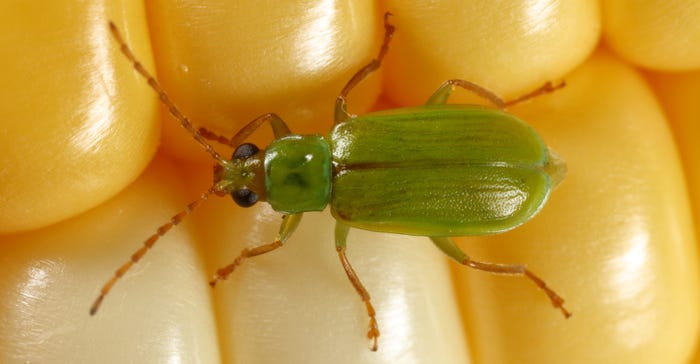
Rainy 2019 was a low spot for Illinois crop yields compared to 2017 and 2018, but it was also a year where insects generally didn’t dominate as they had in years past. This is because of historic rains and the negative impact waterlogged soils had on egg hatches.
But in 2020, corn rootworm is a concern, says Nick Seiter, University of Illinois entomologist.
In 2018, northeastern Illinois averaged a whopping 26.56 northern corn rootworm beetles per 100 sweeps, while rain in 2019 brought that number down to 0.32 beetle.
“When you have those saturated conditions, and the eggs are either actively hatching or you have those small neonate larvae out there, that really puts a hammer on corn rootworm,” Seiter says, adding late-planted cornfields also played a role. As larvae hatched through late May and early June, they starved within hours of not finding corn. Historically, corn rootworm is the leading pest for corn in Illinois.
Seiter says corn rootworm, particularly the western species, is largely under control thanks to wide adoption of the pyramid Bt trait. The uptick of northern corn rootworm in 2018 was constrained to northeastern Illinois, and with that area experiencing a high percentage of prevented and delayed planting fields last year, he says the pest is likely to scale back closer to recent averages in the 2020 season.
“Back in ’08, ’07, the numbers were quite a bit higher, especially for western corn rootworm. But then that’s where we had the introduction of those pyramid Bt traits. Several years of saturated soil conditions helped, too,” Seiter says. Corn rootworm-resistant hybrids first were commercialized in 2003.
Pioneer agronomist Matt Montgomery describes the widespread adoption of Bt technology as “halting the western advance” of the pest — so much so that today, some of his western Illinois growers opt for corn borer-resistant hybrids instead on rotated ground.
“If it’s rotated ground, we talk about corn borer products,” Montgomery says. “We really aren’t so much focused on western corn rootworm. And we continue to monitor the sticky traps to see if that story changes. But up to this point, the pressure on rotated ground has been really low.”
Seiter says even before 2008 and 2009, northern corn rootworm was in decline. That’s now changing, with the Dakotas reporting northern corn rootworm being less susceptible, and even resistant, to Bt traits.
“Northern populations have been creeping up for the last few years in Illinois, last year notwithstanding,” Seiter says, noting he and his team have observed fields with high populations that suffer “more damage than we would expect.”

WEST AND NORTH: Populations of both western and northern corn rootworm remain manageable in most of the state, according to surveys, U of I entomologist Nick Seiter says. But, he cautions, “that doesn’t mean there won’t be pockets of higher populations.”

“The only place we’ve confirmed resistance through a laboratory assay is in the Dakotas. But it’s something we’re watching,” Seiter says. He adds that farmers with fields with high corn rootworm populations have effective soil insecticides they can deploy at planting, as well as resistant hybrids.
Farmers interested in assessing corn rootworm populations with traps could also look at the damage inflicted by digging up roots and assessing node damage.
In a University of Illinois trial, non-Bt, non-insecticide corn had a mean node injury rate ranging from 0.78 to about 0.89 at the R1 growth stage, which in 2019 was late in July. Seiter cautions that damage “came with relatively low rootworm pressure.” The highest rating would be a pruning of all three nodes, 3.0. The lowest would be no damage.
He concludes that he’s looking forward to observing black cutworm flights and sharing up-to-date information at bulletin.ipm.illinois.edu.
Research essential but pared down
Despite COVID-19, Montgomery says his company’s 2020 crop trials are continuing “uninterrupted” in order to supply important data for studies. However, the company has opted to limit customer-to-employee interactions, using digital tools such as telemetry and video conferencing to cut down on the time employees spend with customers.
University of Illinois, on the other hand, plans to minimize nonessential research. While the research university will continue projects it’s paid to conduct through grants and industry partnerships, other important functions for university labs are being put on hold. Ag researchers are allowed access to campus labs when needed, but traveling to research plots is a challenge.
“Since seasonal research is such a big part of what we do in crop sciences, we’ve been able to do the basic, bare-minimum shipments and other things we have to do to keep up on our projects,” Seiter says.
“We always like doing a little extra research every year, and it looks like those extras are going to get cut,” he concludes.
About the Author(s)
You May Also Like




